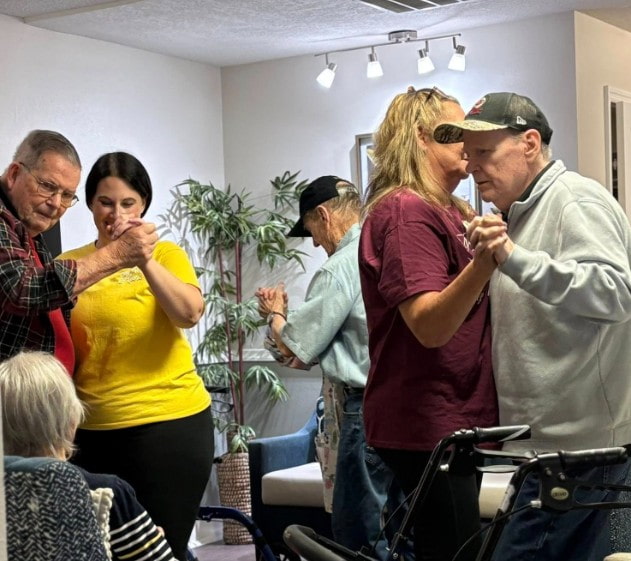What happens in the mind when the body begins to move?
Why does music from decades ago suddenly awaken forgotten emotions?
Can rhythm reconnect us with the memories that time once hid?
For centuries, dance has accompanied humanity through celebration, healing, and transformation. Ancient cultures used movement as medicine, ritual, and memory—an instinctive way to express what words could not. Today, neuroscientists and therapists find echoes of that wisdom: coordinated movement, rhythm, and touch stimulate areas of the brain linked to memory, emotion, and balance.
In Memory Care, this connection between rhythm and remembrance takes on new meaning. Dance offers gentle exercise, emotional release, and moments of genuine connection. The body remembers what the mind forgets, and through every sway and step, residents rediscover fragments of identity, joy, and belonging.
How Dance Stimulates the Brain in Dementia Care
Close your eyes for a moment and imagine a melody that once defined a part of your life, perhaps the song played at your wedding, or the tune that filled the air at family gatherings. Notice how your body remembers even before your mind does. A slight tap of your foot, the rise of your chest as the rhythm catches you, movement and memory have always been intertwined.
That’s precisely where dance begins its quiet work in Memory Care. It’s not about choreography or skill; it’s about awakening instinct. When seniors with dementia engage in rhythmic movement, they reconnect with parts of the self-untouched by cognitive decline. This simple act restores dignity and identity.

What Science Sees in the Dance
Now, let’s lift the curtain and observe the brain at work. Dancing is one of the few human activities that simultaneously engages motor coordination, emotion, rhythm perception, and social interaction.
When a person dances, their brain lights up in a networked symphony:
- The cerebellum handles balance and timing.
- The motor cortex controls motion.
- The prefrontal cortex engages focus and sequencing.
- The hippocampus—the center of memory—activates when familiar songs or learned movements are repeated.
According to Brown et al. (2006), rhythmic movement increases neuroplasticity, the brain’s ability to form new connections. Similarly, a study in Frontiers in Aging Neuroscience (Kattenstroth et al., 2013) found that older adults who participated in dance-based activities showed enhanced cognitive flexibility and better postural control than those who did not.
Dr. Rebecca Barnstaple, a neuroscientist specializing in dance therapy, notes that “Dance activates emotional and motor pathways that remain intact long after language and abstract reasoning have declined.” This means that even when memory fades, the embodied sense of rhythm persists—what we might call “the muscle memory of joy.”
Imagine a resident named Helen who no longer recalls her daughter’s name but instinctively sways to the waltz her husband once played. Her body speaks the language her mind cannot. That’s dance therapy in motion.
The Brain’s Reward System in Motion
Beyond physical movement, dancing triggers the dopaminergic system, the same network involved in pleasure and motivation. The release of dopamine and endorphins fosters a sense of well-being, helping combat anxiety, depression, and apathy, common in dementia.
According to Blood and Zatorre (2001), listening to pleasurable music stimulates the brain’s reward centers in a manner comparable to eating or social bonding. When paired with dance, this stimulation becomes physical, integrating emotion, cognition, and movement into one unified experience.
The result?
- Lower cortisol (stress hormone) levels
- Improved sleep quality
- Enhanced mood regulation
In Memory Care, this isn’t a small achievement, it’s the return of presence.
Dimensions of Well-Being Unlocked Through Dance
Dance is not a single act of movement; it’s a multi-sensory experience that engages every layer of being: cognitive, emotional, physical, social, and even spiritual. When seen through these dimensions, its therapeutic depth becomes clearer.
Cognitive Awakening
Every movement pattern trains the brain to anticipate, adapt, and respond.
- Repetition of rhythm enhances neuroplasticity and supports memory retrieval.
- Sequenced steps encourage planning and attention, strengthening executive functions.
- Familiar tunes re-stimulate the hippocampus, linking rhythm with recognition.
- Coordinated motion helps maintain cognitive flexibility and decision-making speed.
Emotional Resonance
Dance reconnects the heart to feeling.
- Rhythmic engagement increases serotonin and dopamine, lifting mood naturally.
- Music and motion evoke long-term emotional memories, even in advanced dementia.
- Movement provides emotional release, easing anxiety and agitation.
- Shared dancing moments rebuild confidence and inner calm.
Physical Harmony
The body becomes the teacher.
- Gentle movement improves balance, coordination, and core strength.
- It enhances circulation and respiratory efficiency.
- Regular participation reduces stiffness and fall risk.
- The rhythm itself trains reflexes—each beat becomes an anchor for balance.
Social Connection
Dance creates community without requiring words.
- Group activities foster trust and belonging.
- Residents mirror each other’s motions, reinforcing empathy and social awareness.
- Physical proximity and synchronized movement generate oxytocin, the bonding hormone.
- Shared rhythm transforms isolation into collective presence.
Spiritual Continuity
There’s a subtle, almost sacred element in how dance reconnects people with their essence.
- The experience of flow restores a sense of unity between body and consciousness.
- Music acts as a bridge to memory, stirring emotions that transcend time.
- Rhythmic immersion can induce calm, similar to meditation.
- It reminds residents—and those around them—that life still moves within.
Movement as Celebration at Madison at Clermont
Every community has its own rhythm, and at Madison at Clermont, that rhythm is joy. Under the guidance of Mark Wright-Ahern, our Lifestyles Director, movement has become a creative language, one that invites residents to reconnect with life through music, laughter, and gentle motion.
Mark’s background is unusually rich: opera, theater, television, education, and music performance. That blend of artistry and science shapes his philosophy; that the brain responds to joy as profoundly as it does to exercise. His programs are not about perfection of movement but about awakening attention, emotion, and connection.
What happens during one of his sessions is as fascinating as it is heartwarming. You might see a resident tapping their hands to a rhythm, smiling at a familiar tune, or sharing a spontaneous laugh with others. These are not random moments of entertainment; they are carefully cultivated spaces of cognitive stimulation and emotional resonance.
Why This Approach Matters
Research in cognitive aging has shown that rhythmic engagement and social movement activate regions of the brain linked to memory, coordination, and emotional regulation (Brown & Parsons, Brain and Cognition, 2008). When these experiences are paired with positive emotion—music, humor, or group participation—the neurological impact deepens.
In other words, the science supports what can be seen in real time at Madison:
- Movement reinforces presence. Even light activity increases blood flow to the hippocampus, which supports memory formation.
- Music revives emotion. Familiar melodies can evoke autobiographical memories that foster identity continuity.
- Shared joy strengthens connection. Social synchronization releases oxytocin, enhancing trust and emotional safety.
A Director with a Performer’s Insight
Mark’s artistic instincts give him an uncommon ability to read energy in a room. Whether through musical cues, humor, or simple interaction, he transforms each gathering into an experience that feels inclusive and alive. His sessions are less about repetition and more about response; how residents mirror rhythm, how they engage curiosity, how they rediscover lightness.
Beyond Therapy—Toward Meaning
At Madison at Clermont, this form of guided movement stands as a reminder that well-being is not only biological but existential. When seniors move to rhythm, they are not merely exercising their muscles, they are reaffirming their presence in the world.
And perhaps that is what makes these classes unforgettable: the way they blend science and soul, the way each smile becomes a proof of awareness, and how a single rhythm can awaken what memory alone cannot.





